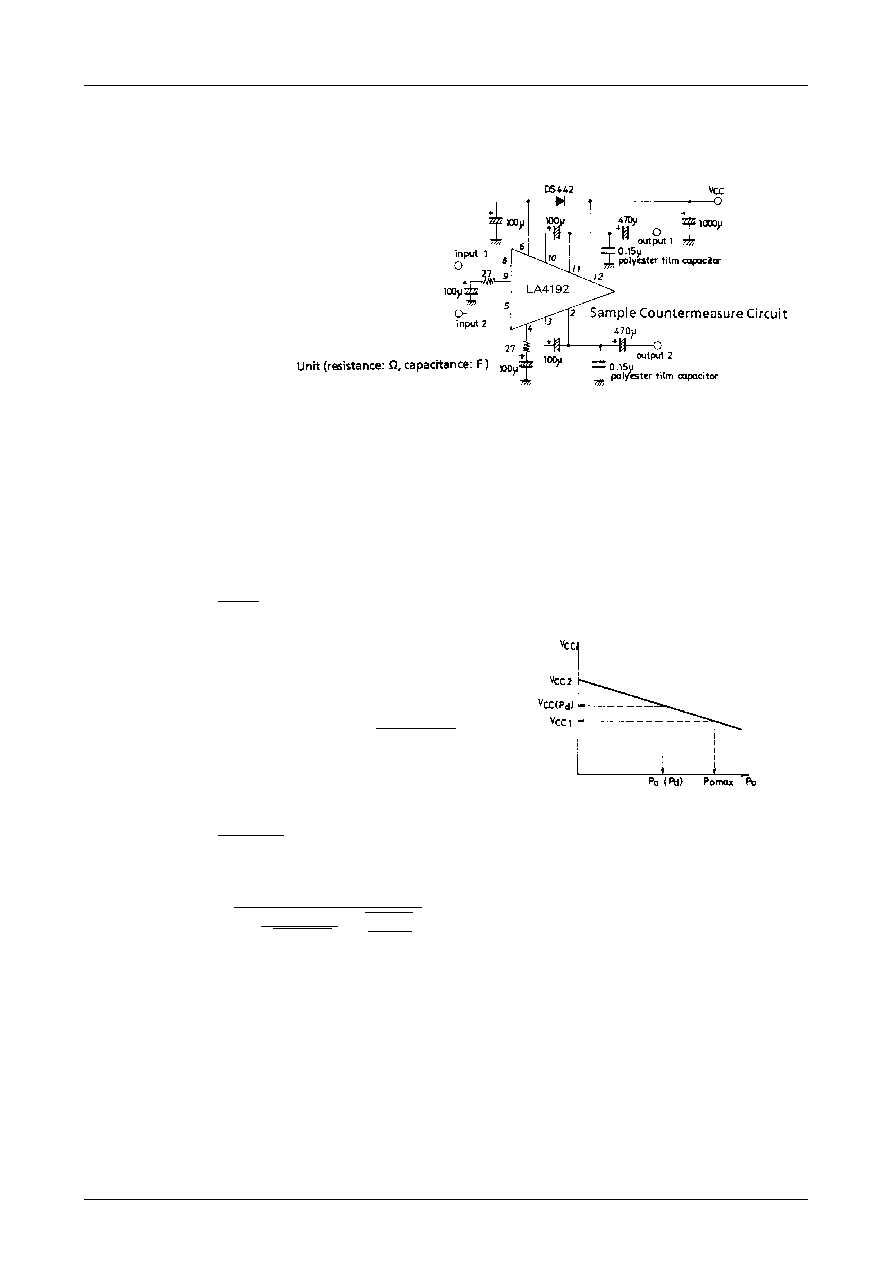- 您現(xiàn)在的位置:買賣IC網(wǎng) > PDF目錄30716 > LA4192 2.3 W, 2 CHANNEL, AUDIO AMPLIFIER, PDIP12 PDF資料下載
參數(shù)資料
| 型號: | LA4192 |
| 元件分類: | 音頻/視頻放大 |
| 英文描述: | 2.3 W, 2 CHANNEL, AUDIO AMPLIFIER, PDIP12 |
| 封裝: | DIP-12 |
| 文件頁數(shù): | 8/11頁 |
| 文件大?。?/td> | 407K |
| 代理商: | LA4192 |

LA4192
No.919–6/11
Caution for LA4192 in sets
When LA4192 is used in a set and driven by AC mains, switching the motor on as shwon below, causes instantaneous
lowering of the power supply voltage, depending on the transformer regulation and other conditions.
Ripple noises are sometimes generated in the speakers or headphones. The following can be used to prevent such prob-
lems.
1. Connect a diode (a rectifier diode with an average
rectified current IO=100 to 200mA) across pins 6
and 12 of LA4192, and have pin 6 potential closely
follow power supply voltage variations. In a steady
state, this diode will be cut off.
2. Use large enough capacitance capacitors for the
power supply to suppress supply votage variations
caused when the motor is switched on.
Heat sink design
As the package is basically heat-dissipated by utilizing a copper foil section of the printed circuit board, the area of
copper foil in the vicinity of the IC heat dissipating plate should be made as broad in area as possible when designing the
printed circuit board. For the sample printed pattern shown earlier, providing copper coil where indicated by the broken
lines will considerably enhance heat sinking. Power consumption (Pd) can be increased depending on power supply
voltage and load conditions. Use of a heat sink in conjunction with the printed circuit board is recommended. Described
below are formulas to provide guidelines for Pd (for 2 channels) under various conditions of usage. For AC power
supplies, it is preferable to take actual measurements at the transformer of sets. For bridge amplifier, simply use 1/2 of
employed loads in computations.
1) DC power supply
Pd max=
+ICCO VCC (for 2 channels) .............................................. (1)
2) AC power supply
VCC2 :
Power supply voltage at no signal
VCC (Pd) :
Power supply voltage at Pd max
VCC1 :
Power supply voltage at maximum output
r :
Voltage regulation
ICCO :
Power supply voltage variation
Pd max=
+ICCO VCC (Pd) (for 2 channels) ............................... (2)
where
VCC (Pd)=
Sample heat sink mounting
Prepare a heat sink as shown on the next page. It is configured to be able to dissipate heat both from the IC plastic surface
and its fins. Solder it on to the printed circuit board. Refer to the Pd – Ta characteristics for size of heat sink. Solderable
copper or steel are preferable. Silicone grease is recommended for application to the IC plastic surface to lower its
thermal resistance with the heat sink.
VCC2
π2R
L
VCC2–VCC1
VCC1
VCC(Pd)2
π2R
L
(1+r) VCC1
r VCC1
√2 π R
L
√
PO max
RL
1+
×
相關PDF資料 |
PDF描述 |
|---|---|
| LA42032 | 5 W, 2 CHANNEL, AUDIO AMPLIFIER, SFM13 |
| LA42032 | 5 W, 2 CHANNEL, AUDIO AMPLIFIER, SFM13 |
| LA42051 | 5 W, 1 CHANNEL, AUDIO AMPLIFIER, SFM13 |
| LA42051 | 5 W, 1 CHANNEL, AUDIO AMPLIFIER, SFM13 |
| LA42052 | 5 W, 2 CHANNEL, AUDIO AMPLIFIER, SFM13 |
相關代理商/技術參數(shù) |
參數(shù)描述 |
|---|---|
| LA4195 | 制造商:未知廠家 制造商全稱:未知廠家 功能描述: |
| LA4195T | 制造商:未知廠家 制造商全稱:未知廠家 功能描述: |
| LA4200 | 制造商:未知廠家 制造商全稱:未知廠家 功能描述: |
| LA42031 | 制造商:ON Semiconductor 功能描述: |
| LA42031-E | 功能描述:音頻放大器 POWER AMPLIFIER RoHS:否 制造商:STMicroelectronics 產(chǎn)品:General Purpose Audio Amplifiers 輸出類型:Digital 輸出功率: THD + 噪聲: 工作電源電壓:3.3 V 電源電流: 最大功率耗散: 最大工作溫度: 安裝風格:SMD/SMT 封裝 / 箱體:TQFP-64 封裝:Reel |
發(fā)布緊急采購,3分鐘左右您將得到回復。